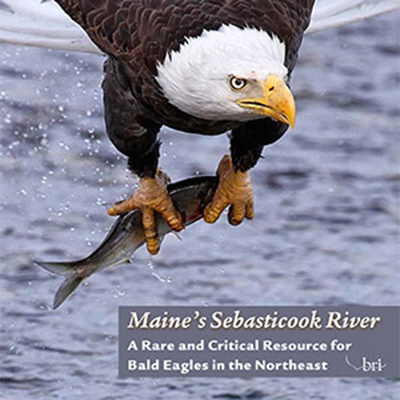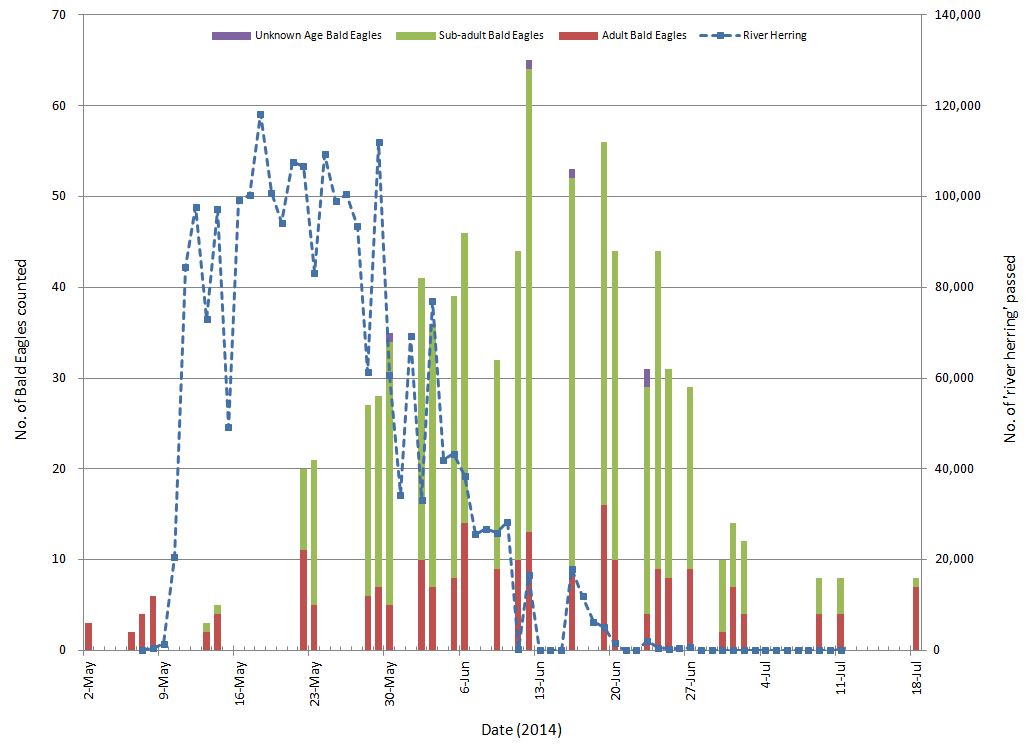Measuring Bald Eagle Use of the River Herring Run on Lower Sebasticook River
Each year, dozens of adult and immature Bald Eagles congregate on the lower Sebasticook River, which stretches from Benton Falls to Waterville, Maine. Eagles from across New England gather here to take advantage of a seasonally abundant food resource–river herring (alewives and blueback herring) heading upstream to spawn in inland lakes.
Due to the combined effects of pesticide use, direct killing, and habitat loss, Bald Eagles (Haliaeetus leucocephalus) were nearly extinct by the mid-20th century. The recovery of this iconic species is due to concerted efforts to prevent its loss through landmark environmental policies in U.S. history, such as the ban on the pesticide DDT and the Endangered Species Act, which protect numerous other species today.
Project Overview

While traditional conservation efforts focused on increasing reproduction at nest sites, management focus is shifting toward protection of eagle aggregation areas. These areas are centered near abundant food sources, typically seasonal fisheries. In 2014, with support from the American Eagle Foundation and local landowners, researchers from BRI and the Maine Department of Inland Fisheries (MDIFW) conducted ground-based and aerial surveys of Bald Eagles using fishing and perching areas on the Sebasticook River.
The lower Sebasticook is a recent eagle aggregation area due to the restoration of river herring. Widespread dam construction blocking migration, long-term overfishing, and water pollution led to drastic declines in river herring, a group of fish including alewives (Alosa pseudoharengus) and blueback herring (Alosa aestivalis). The recent installation of a fish lift at the Benton Falls Dam and the Fort Halifax Dam’s removal enable river herring migrating from the ocean to reach expanded spawning habitat in upland lakes and streams.
Like the Sebasticook River, riparian corridors concentrate migrating fish in large quantities called runs, which provide a reliable and abundant food resource for Bald Eagles and other wildlife even during the harsh winter months. These fish runs boost the survival of immature (younger than 3½ years old) Bald Eagles, which play a large role in the overall population’s stability.
Download our outreach brochure summarizing study findings: DeSorbo, C. R., D. Riordan, and E. Call. 2015. Maine’s Sebasticook River: A Rare and Critical Resource for Bald Eagles in the Northeast. Biodiversity Research Institute, Portland, Maine, and Maine Department of Inland Fisheries & Wildlife, Bangor, Maine. 6 pp.
Project Goals

The survival of immature Bald Eagles is key for stability of their population, yet the behavior of this population sector is poorly understood. Conservation management efforts traditionally focused on protecting nest sites tend to overlook nonbreeding Bald Eagles and their habitat, as they are not yet associated with nests. Instead, efforts to protect areas containing seasonally abundant resources, where nonbreeders often aggregate, contribute to the long-term stability of Maine’s thriving, but still sensitive, eagle population.
No prior research efforts have focused on quantifying Bald Eagle use of the Sebasticook River. This project by BRI and MDIFW aims to provide data for informed decisions on the conservation of piscivorous raptors, river herring, and the critical habitats that support them.
Study Area & Findings
Study Area
Important Bald Eagle foraging areas identified by analyzing significant clusters, or “hotspots” (indicated by red areas), of perching locations documented during 2014 survey efforts. The map shows five of the surveyed areas (indicated by dashed green line), those furthest upstream and closest to the Benton Falls Dam. In total, ten sites along the lower Sebasticook were surveyed.

Findings
Daily river-wide estimates of adult and subadult Bald Eagles counted along a five-mile stretch of the Sebasticook River, Maine, compared with numbers of river herring that passed through the Benton Falls fish lift. The apparent time lag between upstream fish passage and the number of eagles is likely explained by post-spawning downstream migrating fish. Downstream fish presumably continue to attract eagles long after the upstream fish migration subsides.

Conservations Efforts- What You Can Do To Help

Get Involved. Many Maine organizations are dedicated to land and wildlife conservation. Participation and membership are critical to their missions.
Conserve Habitat. Shoreline trees stabilize riverbanks, and are used by eagles to perch while foraging. Riverfront property owners can protect eagles, fish popualations, and other wildlife by obeying municipal shoreland zoning ordinances, which help conserve water quality and minimize erosion.
Be Responsible. Keep a respectful distance fom nesting trees and foraging eagles. Properly discard used fishing line and hooks that can entangle wildlife. Use non-lead fishing weights and ammunition, which many sportsmen now prefer due to improved performance and lower risk of human exposure to lead.
Make a Donation. Private donations play a critical role in conservation. You can support Bald Eagle conservation and research in Maine by contributing to BRI’s Bald Eagle Research Fund and by supporting the Maine Department of Inland Fisheries and Wildlife. Support MDIFW conservation efforts through the Chickadee Tax Check-off, the Loon Conservation Plate, Maine Birder Bands, and special lottery ticket sales (Maine Outdoor Heritage Fund).
If You Are a Lower Sebasticook River Landowner:
Central Maine is one of the strongholds of New England’s breeding Bald Eagle population—particularly during years of low reproduction. This region also hosts what is probably the highest summer concentration of juvenile eagles in the northeastern U.S. These two sectors of the population—breeders and nonbreeders—jointly play a key role in influencing the stability of the broader Bald Eagle population in the northeast. Landowners in central Maine, especially those along the Lower Sebasticook River corridor, have a unique opportunity to promote the conservation of Bald Eagles and their habitat in this region, thereby benefitting fish, people, and a diverse array of wildlife for generations to come.
Download our landowner brochure: DeSorbo, C. R. and J. Brockway. 2018. The Lower Sebasticook River: A landowner’s guide for supporting one of Maine’s most unique and important ecosystems. Produced by Biodiversity Research Institute, Portland, Maine. Reviewed by the Maine Department of Inland Fisheries and Wildlife, Bangor, Maine, and Maine Department of Marine Resources, Augusta, Maine. BRI Science Communication Series No. 2018-15. 8 pp.
Downloads
DeSorbo, C. R. and J. Brockway. 2018. The Lower Sebasticook River: A landowner’s guide for supporting one of Maine’s most unique and important ecosystems. Produced by Biodiversity Research Institute, Portland, Maine. Reviewed by the Maine Department of Inland Fisheries and Wildlife, Bangor, Maine, and Maine Department of Marine Resources, Augusta, Maine. BRI Science Communication Series No. 2018-15. 8 pp.
DeSorbo, C. R., D. Riordan, and E. Call. 2015. Maine’s Sebasticook River: A Rare and Critical Resource for Bald Eagles in the Northeast. Biodiversity Research Institute, Portland, Maine, and Maine Department of Inland Fisheries & Wildlife, Bangor, Maine. 6 pp.
DeSorbo, C. R., D. Riordan E. Call and R. B. Gray. 2015. Quantifying the Value of New England’s Premier River Herring Run by Bald Eagles. Biodiversity Research Institute, Portland, ME. Report #2015-09 submitted to the American Eagle Foundation, Pigeon Forge, TN and the Maine Dept of Inland Fisheries and Wildlife, Bangor, ME. 40 pp.
DeSorbo, C. R., D. Riordan, J. Tash, R. B. Gray and William Hanson. 2015. Documenting Areas of Importance to Maine Subadult Bald Eagles: Insights from Satellite Telemetry. Report #2014-24 submitted to the Maine Outdoor Heritage Fund, Portland, Maine, The Bailey Wildlife Foundation, Cambridge MA, and the Maine Department of Inland Fisheries & Wildlife, Bangor ME. 38 pp.
Collaborators and Funders
Our studies on the Sebasticook were supported by The American Eagle Foundation, The Davis Conservation Foundation, and The Nature Conservancy.
Photo Credits: Cover of brochure: Bald Eagle © John R. Rivers. Bald Eagle on river rock © Sharon Fiedler. Both Eagle aggregations © Jeanne M. Coleman. Fish passage data courtesy of Maine Department of Marine Resources.


